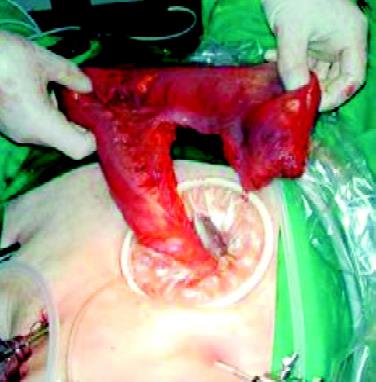Laparoscopic Colorectal Surgery
Introduction
Laparoscopic colon resections are being performed with increasing frequency all over the world, though the use of minimal access surgery in colorectal surgery has lagged behind its application in other surgical fields. Since the first laparoscopic colectomy was described in 1991, a great deal of controversy has surrounded its use, particularly in the management of colorectal cancer. After the successful introduction of laparoscopic colectomy by Jacobs, laparoscopic surgery for the treatment of colorectal cancer, especially laparoscopic rectal surgery, has been developed considerably. Several important new studies have demonstrated the benefits and safety of laparoscopic colorectal surgery, making it now the preferred approach in the surgical management of many colorectal diseases.
The technique of laparoscopic colectomy has a long learning curve because of the advanced laparoscopic skills it entails. Unlike other laparoscopic procedures, such as the Nissen fundoplication or cholecystectomy, colorectal procedures involve dissection and mobilization of intraabdominal organs in multiple quadrants. Tilting of the operating-room table in various positions during an operation uses gravity to allow intra-abdominal organs to fall away from the area of dissection, providing necessary exposure that would normally be achieved through the use of retractors. Intestinal resection requires laparoscopic ligation of large vessels, mobilization and removal of a long floppy segment of the colon, and restoration of intestinal continuity. Once the colon segment has been completely mobilized and its blood supply divided, a small skin incision is made to exteriorize the colon, resection, and anastomosis are performed extracorporeally, and the rejoined colon is placed back into the abdomen.
The laparoscopic approach continues to gain popularity and has evolved to include not just "pure" laparoscopic techniques but also hand-assist devices. Hand-assisted surgery can be used as a bridge for surgeons who are not completely familiar or facile with laparoscopic techniques, and even for the most experienced laparoscopic surgeons, it is often the preferred technique for surgery involving left-sided pathology. The use of a hand-assist device provides tactile feedback for the surgeon and shortens operating-room time while still preserving many of the advantages of laparoscopic surgery. By combining laparoscopic surgery with the tactile feedback of a hand-assisted device, surgeons can reduce operating-room time and have a lower procedure conversion rate. The technique involves making an incision the width of a hand and placing a hand-assist device to facilitate laparoscopic dissection. New hand port devices make this technique possible without loss of pneumoperitoneum, which is essential for performing laparoscopic procedures. Because an incision (4–5 cm) is necessary to remove the colon specimen at the end of a laparoscopic operation, the difference between a pure laparoscopic procedure and a hand-assisted operation is generally a few additional centimeters (3–4 cm) of incision length. Several clinical trials have demonstrated that there is no difference in patient recovery or discharge for laparoscopic versus hand-assisted techniques. Larger incisions are often needed and because of the increased risk of wound infections and pulmonary complications, this technique has particular advantages with overweight or obese patients.

Hand-assisted colorectal surgery
Most patients are candidates for a laparoscopic approach. When the surgeon is experienced, even patients with a history of abdominal surgery are candidates. Though there are clear benefits, they have not been as compelling when compared to the clear advantages associated with other laparoscopic procedures. The main reason is that a colectomy, whether open or laparoscopic, results in a delayed return of bowel function. Though recovery of bowel function is quicker after laparoscopic surgery, the difference is on the order of one or two days, resulting in a similar reduction in length of hospital stay. Also, the laparoscopic approach is associated with longer operating-room times. Even if long-term benefits are equivalent between open and laparoscopic techniques, the short-term benefits are real advantages for patients. In practical terms, the laparoscopic approach is associated with less pain, a faster recovery, earlier return of bowel function, a shorter hospital stay, possible immune benefits, and smaller scars, making it the preferred method for intestinal resection.
The lack of tactile feedback during laparoscopic surgery can make tumor localization difficult, especially if the lesion location has not been tattooed on the colon wall before surgery. It is imperative that the exact location of the tumor is known prior to proceeding with colectomy. Even when the lesion location has been tattooed onto the colon, often the mark can be difficult to see, or there may be confusion regarding the location of the tattoo in relation to the tumor (proximal or distal), which can affect surgical margins. Intraoperative colonoscopy is a way of definitively localizing a lesion and should be available during all laparoscopic colectomies. A traditional colonoscopy uses room air as the insufflating gas, which leads to significant bowel distension and requires clamping of the proximal colon to minimize this effect. Clamping the bowel can lead to injury, and even when it is successfully performed, the degree of distension often makes simultaneous laparoscopic visualization difficult. These problems can be circumvented with the use of CO2, rather than room air, as the insufflating gas. Because CO2 is absorbed much more rapidly than room air, bowel distension is minimized and dissipates quickly, making proximal clamping unnecessary. The use of CO2 allows for laparoscopic and endoscopic procedures to be performed simultaneously, and this technique has been shown to be safe and clinically useful. Besides tumor localization, CO2 colonoscopy may have other potential applications.





